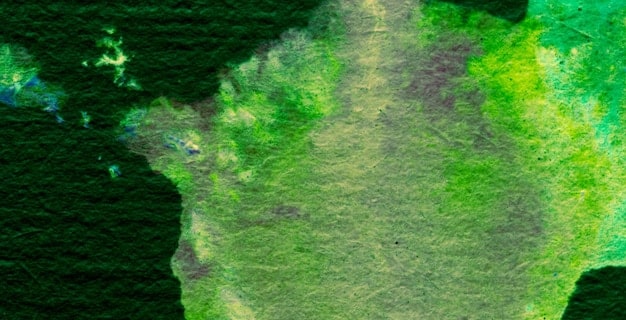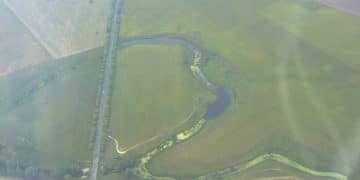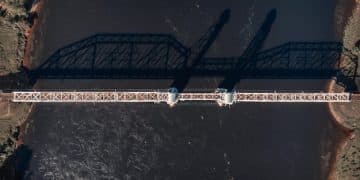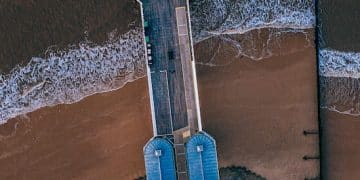Implications of Supreme Court’s EPA Wetland Ruling

The Supreme Court’s ruling on the EPA’s authority over wetlands has significantly narrowed the agency’s jurisdiction, redefining protected waterways and potentially altering environmental conservation efforts across the United States.
Understanding what are the implications of the Supreme Court’s ruling on the EPA’s authority over wetlands requires a deep dive into legal precedents, environmental policy, and their intersection with property rights. This landmark decision reshapes how crucial aquatic ecosystems are regulated, impacting everything from development projects to biodiversity conservation.
Understanding the Court’s Decision and Its Precedents
The Supreme Court’s recent decision regarding the Environmental Protection Agency’s (EPA) authority over wetlands, specifically in the case of Sackett v. EPA, represents a pivotal moment in American environmental law. At its core, the ruling seeks to clarify the scope of the Clean Water Act (CWA), a foundational piece of legislation designed to protect the nation’s waters. For decades, the definition of “waters of the United States” (WOTUS), central to the CWA, has been a source of legal and regulatory contention, leading to fluctuating interpretations and enforcement challenges.
Prior to Sackett, the EPA and the U.S. Army Corps of Engineers (USACE) generally operated under a broader interpretation of WOTUS, often extending protection to wetlands that had a significant nexus—ecological or hydrological connection—to traditionally navigable waters. This approach, while aiming for comprehensive environmental protection, also created ambiguity for landowners and developers needing to determine if their properties contained regulated wetlands.
Historical Context of Wetland Regulation
The legal battle over wetland jurisdiction is not new. It traces back to fundamental disagreements about federal versus state authority and the balance between environmental protection and private land use. Landmark cases such as Rapanos v. United States (2006) showcased the fractured nature of the Court’s views, where no single majority opinion emerged, leading to continued uncertainty. Justice Kennedy’s “significant nexus” test from Rapanos eventually became the prevailing standard, allowing the EPA to regulate wetlands that, alone or in combination with similarly situated lands, significantly affected the chemical, physical, and biological integrity of navigable waters.
This historical backdrop of shifting legal interpretations underscores the complexity of defining WOTUS. Each ruling, regulation, and guidance document has contributed to a layered understanding, or misunderstanding, of federal jurisdiction. Landowners have often faced lengthy and costly processes to obtain permits, or sometimes even clarity, on whether their property fell under federal purview.
The concept of “navigable waters” itself is critical here. The CWA grants federal jurisdiction over these waters and their adjacent wetlands. “Adjacent” has been broadly interpreted to include not only contiguous wetlands but also those with a significant ecological connection. This has allowed for protection of isolated wetlands and ephemeral streams that are vital for broader ecosystem health, even if not directly connected by surface water year-round.
Understanding these precedents is crucial to grasping the magnitude of the Sackett ruling. It’s not merely a tweak to existing law but a fundamental re-evaluation of the Clean Water Act’s reach, with profound implications for how the nation’s wetlands are identified, protected, and potentially impacted by future development.
Shrinking Federal Jurisdiction: What it Means for Wetlands
The Supreme Court’s decision in Sackett v. EPA significantly curtails the federal government’s authority over wetlands, particularly those not directly connected to larger, navigable bodies of water. The ruling rejects the long-standing “significant nexus” test, replacing it with a far more restrictive standard based on an “adjacent” connection to traditionally navigable waters. This change profoundly impacts which wetlands will fall under federal protection, leaving a substantial portion vulnerable to development without federal oversight.
The new standard establishes that wetlands are only considered “waters of the United States” if they are indistinguishable from “waters proper” and have a continuous surface connection to traditionally navigable waters or their tributaries. This narrowly defined scope means that many wetlands previously protected under the Clean Water Act, such as those separated by a dike or small man-made barrier, or those connected only through groundwater, may no longer qualify for federal protection.
Redefining “Adjacent” and “Continuous Surface Connection”
- The ruling narrows the definition of “adjacent” to require a direct and continuous surface connection, essentially limiting federal jurisdiction to wetlands directly bordering or inundated by navigable waters.
- It explicitly rejects the “significant nexus” test, which allowed for protection based on ecological connection, regardless of direct surface flow.
- This new interpretation excludes many geographically isolated wetlands, prairie potholes, and even some types of vernal pools from federal protection, despite their critical ecological roles.
This redefinition has immediate and far-reaching consequences for wetland conservation. Historically, wetlands have functioned as vital natural infrastructure: they filter pollutants, absorb floodwaters, provide critical habitats for diverse species, and recharge groundwater. By removing federal oversight from a large subset of these ecosystems, the ruling shifts the burden of protection more heavily onto state and local governments, which may have varying levels of resources and commitment to environmental regulations.
The lack of consistent federal protection could lead to a patchwork of environmental standards across the country, potentially creating competitive disadvantages for states with stronger wetland regulations. Developers might gravitate towards areas with weaker protections, leading to increased wetland degradation and loss in those regions. Furthermore, the ruling could complicate interstate water quality management, as the health of one state’s waters often depends on the health of wetlands upstream or in neighboring states, regardless of their direct surface connection.
In essence, the decision means a significant reduction in the types of wetlands requiring federal permits for disturbance or development. This shift could streamline approval processes for some developers, but it simultaneously raises serious concerns among environmental advocates about potential widespread environmental harm, loss of biodiversity, and diminished water quality over time.
Environmental Consequences: Biodiversity, Water Quality, and Climate Change
The narrowing of federal jurisdiction over wetlands carries substantial environmental consequences, impacting biodiversity, water quality, and the nation’s resilience to climate change. Wetlands are not merely wet patches of land; they are intricate ecosystems that provide a myriad of ecological services essential for human well-being and planetary health.
One of the most immediate concerns is the potential loss of biodiversity. Wetlands are biological hotspots, supporting a disproportionately high number of plant and animal species, including migratory birds, fish, amphibians, and rare plants. Many species rely on specific wetland types for breeding, feeding, and shelter. With reduced federal protection, many isolated or intermittently connected wetlands could face accelerated destruction or degradation from development, agriculture, or other human activities. This could lead to a decline in populations of wetland-dependent species, potentially pushing some toward endangerment or extinction, thereby diminishing overall ecological resilience.
Water quality is another critical area of impact. Wetlands act as natural filters, removing pollutants, sediments, and excess nutrients from water before it enters streams, rivers, lakes, and oceans. They essentially serve as the “kidneys” of the landscape. For example, a wetland can absorb agricultural runoff containing nitrates and phosphates, preventing harmful algal blooms in downstream water bodies. When these wetlands lose federal protection, their capacity to perform this vital filtering function can be compromised. Unregulated development or conversion of these wetlands could lead to increased pollution of adjacent and downstream waters, impacting drinking water sources, recreational areas, and aquatic life.

Furthermore, wetlands play a crucial role in mitigating the effects of climate change. They serve as significant carbon sinks, storing vast amounts of carbon in their soils and vegetation. When wetlands are drained or destroyed, this stored carbon is released into the atmosphere as carbon dioxide, contributing to greenhouse gas emissions. Beyond carbon storage, wetlands, particularly coastal wetlands, act as natural buffers against extreme weather events. They absorb floodwaters from heavy rainfall and storm surges, reducing damage to human infrastructure and communities. The loss of these protective barriers could exacerbate the impacts of more frequent and intense storms predicted with climate change, increasing flood risks and property damage.
The interconnectedness of these environmental elements means that the implications of the ruling are far-reaching. A decline in wetland health in one region can have cascading effects on ecosystems and communities hundreds of miles away. The ruling thus poses a complex challenge for maintaining ecological integrity in an era of increasing environmental stressors.
Economic and Development Impacts of the Ruling
The Supreme Court’s ruling on EPA’s authority over wetlands has significant economic and development implications, creating both perceived opportunities and potential long-term costs. For some developers and industries, the decision is seen as a welcome simplification of regulatory processes, potentially reducing the time and expense associated with obtaining federal permits for projects impacting wetlands.
Without the need for extensive EPA and USACE review and permitting under the Clean Water Act, projects on previously regulated, but now unprotected, wetlands may proceed more quickly and with fewer federal conditions. This could particularly benefit industries such as real estate development, agriculture, and resource extraction (e.g., mining, oil and gas), which often encounter wetlands on their prospective project sites. The perceived reduction in regulatory hurdles could lead to lower development costs and faster project timelines, potentially stimulating economic activity in certain sectors and regions. This simplification might also be viewed as a boost to property rights, giving landowners more direct control over their land without federal interference.
Potential Economic Shifts and Regulatory Variability
- The ruling may streamline permitting for development on wetlands no longer under federal jurisdiction, potentially reducing project costs and timelines.
- It could lead to a patchwork of state-level regulations, creating economic disparities between states with strong environmental laws and those with weaker ones.
- Industries reliant on natural resources might see reduced regulatory burdens, but face increased local opposition or state-level hurdles.
However, these economic benefits may come with significant trade-offs and hidden costs. The shift of regulatory responsibility to states could result in a fragmented regulatory landscape. States vary widely in their capacity, resources, and political will to enact and enforce comprehensive wetland protection laws. Some states may step up to fill the regulatory void, implementing their own stringent rules, while others may choose not to, leading to significant inconsistencies in environmental protection across the country. This variability could create uncertainty for businesses operating across state lines and potentially lead to an uneven playing field.
Moreover, the long-term economic costs associated with wetland loss can be substantial. As discussed, wetlands provide invaluable ecosystem services like natural flood control, water purification, and support for fisheries and tourism. The degradation or destruction of these wetlands due to reduced federal oversight could lead to increased expenditures on artificial flood control measures, water treatment infrastructure, and disaster recovery. For instance, the economic value of wetlands as natural flood barriers far exceeds the cost of preserving them. A decline in water quality could impact industries reliant on clean water, such as fishing, tourism, and recreation, leading to economic losses in those sectors.
In the agricultural sector, while farmers might have more flexibility in managing their land, the loss of wetlands could reduce natural pest control and water retention capabilities, potentially impacting crop yields and increasing reliance on external inputs. Ultimately, while certain development projects might see immediate gains, the broader economic resilience of communities and industries often depends on healthy, functioning ecosystems, a factor that the ruling may undermine in the long run.
State-Level Responses and the Shifting Regulatory Landscape
Following the Supreme Court’s decision, the regulatory landscape for wetlands has fundamentally shifted, placing a greater onus on individual states to protect these vital ecosystems. This shift is leading to a diverse range of state-level responses, highlighting the patchwork approach to environmental governance now emerging across the United States. States with robust existing environmental laws and strong political will for conservation are more likely to enact their own regulations or strengthen existing ones to fill the void left by diminished federal oversight. Conversely, states with less established environmental protections or different political priorities may not act, or may even actively reduce, their wetland conservation efforts.
Many states are now assessing their current wetland programs to determine if they are adequate to protect newly unprotected wetlands. Several states, particularly those with a history of strong environmental stewardship, are already exploring or implementing legislative actions to expand their jurisdictional reach over intrastate waters and wetlands. This might involve updating state-specific definitions of “waters of the state” to include features that no longer fall under federal WOTUS, or increasing funding for state agencies responsible for wetland mapping, permitting, and enforcement.
For example, some states might broaden their regulatory scope to include “isolated wetlands” or “ephemeral streams” that were previously subject to federal review. This could involve developing more comprehensive state-level permitting programs, requiring state-specific environmental impact assessments for projects affecting such wetlands, and increasing enforcement capabilities. The challenge, however, lies in the resource allocation for these expanding responsibilities, as many state environmental agencies are often underfunded and understaffed.

The divergence in state approaches could lead to significant variations in environmental outcomes. Developers operating in states with weaker regulations might find it easier and cheaper to build on wetlands, potentially leading to increased wetland loss in those areas. This could also create “pollution havens” where industries might gravitate due to lax environmental oversight. Conversely, states that implement strong protections might face concerns about economic competitiveness if businesses perceive their regulations as overly burdensome. The dynamic between environmental protection and economic development will play out differently in each state, reflecting local political and economic contexts.
Furthermore, the lack of uniform federal standards could complicate regional and interstate environmental issues. For instance, pollution originating from unprotected wetlands in one state could still impact water quality in a downstream state, creating cross-border environmental challenges without a consistent federal framework to address them. The overall impact of this shifting regulatory landscape will depend heavily on the proactive measures taken by individual states and the balance they strike between economic interests and environmental stewardship.
Future Outlook for Environmental Policy and Advocacy
The Supreme Court’s ruling on EPA’s authority over wetlands is poised to significantly reshape the landscape of environmental policy and advocacy in the United States for years to come. This decision effectively pushes environmental protection responsibilities further down to state and local levels, intensifying existing debates and catalyzing new strategies for conservationists, policymakers, and industry stakeholders alike.
One of the most immediate shifts will be the increased focus on state-level lobbying and legislative efforts. Environmental advocacy groups will likely redirect resources to states, pushing for the adoption of more stringent wetland protection laws where federal oversight has receded. This could lead to a proliferation of “mini-Clean Water Acts” at the state level, reflecting local priorities and capacities. However, success will be uneven, depending on the political composition and public support for environmental causes in each state. Industry groups, conversely, will also focus on state legislatures to advocate for less restrictive regulations, creating intense legislative battles at the local level.
Furthermore, the ruling may spur new forms of collaboration and litigation. Local communities and conservation organizations might increasingly rely on common law nuisance claims or state-specific environmental statutes to challenge projects impacting unprotected wetlands. There could also be an uptick in citizen suit provisions within state laws, allowing individuals or groups to enforce environmental standards directly. Legal strategies will need to adapt to emphasize state-specific environmental impact assessments (EIAs) and permitting processes, scrutinizing projects that might have previously required federal review.
The role of federal agencies like the EPA and USACE will also evolve. While their direct regulatory reach over wetlands has been curtailed, they may shift their focus towards providing technical assistance, scientific research, and funding to states that choose to bolster their wetland programs. There could also be increased emphasis on voluntary conservation programs, incentives for landowners, and restoration efforts that are not contingent on federal jurisdiction. The federal government might also explore other legislative avenues, though congressional action on environmental issues remains challenging in a divided political climate.
Long-term implications include a potential widening of the gap between states with strong environmental protections and those with weaker ones, leading to varying levels of environmental quality across the nation. This unevenness could challenge the principles of environmental justice, as vulnerable communities might disproportionately bear the burden of environmental degradation in areas with lax regulations. The ruling also underscores the importance of public awareness and education regarding the value of wetlands. Advocacy efforts will likely intensify to inform the public about the vital ecosystem services wetlands provide, aiming to build broader support for their protection at all levels of government.
In essence, the future of environmental policy regarding wetlands will be characterized by decentralization, increased state autonomy, and a complex interplay of legal, political, and advocacy strategies aimed at navigating the redefined legal landscape.
Navigating the New Regulatory Framework: Advice for Stakeholders
In light of the Supreme Court’s decision on the EPA’s authority over wetlands, navigating the evolving regulatory framework requires careful consideration and proactive strategies for all stakeholders. The shift away from a broad federal oversight necessitates a thorough understanding of revised jurisdictional boundaries and increased reliance on state-specific regulations.
For landowners and developers, the primary advice is to exercise caution and conduct meticulous due diligence. While federal permitting requirements may have decreased for certain wetlands, it is crucial to recognize that many states have their own, often robust, wetland protection laws. A wetland that no longer falls under federal jurisdiction might still be protected by state, tribal, or even local municipal regulations. Therefore, before initiating any land-altering activities, a comprehensive assessment of all applicable state and local environmental laws is essential. Consulting with environmental attorneys or land-use planners familiar with current state regulations can help mitigate legal risks and avoid costly delays or penalties.
Environmental consultants also have an evolving role. They must now possess deep expertise not only in federal environmental laws but also in the myriad of diverse state and local regulations. Their services will be invaluable in helping clients navigate the complex patchwork of rules, conduct accurate wetland delineations based on revised criteria, and prepare appropriate state-level permits. Understanding the nuances of each state’s approach will be critical for providing effective advice.
For state and local governments, the challenge is to assess their current regulatory capacities and determine if they are adequately equipped to manage the newly unprotected wetlands within their borders. This may involve reviewing existing statutes, considering new legislation, increasing staffing for environmental agencies, and investing in wetland mapping and monitoring programs. Establishing clear, publicly accessible guidance on state-specific wetland definitions and permitting processes will be key to avoiding confusion and ensuring effective conservation.
Environmental advocates and conservation organizations must adapt their strategies from primarily federal lobbying to a more decentralized, state-by-state approach. This involves building stronger coalitions at the local level, engaging in public education campaigns to raise awareness about the importance of wetlands, and advocating for robust state-level protections. Litigation efforts may also shift, focusing more on enforcing state environmental laws and challenging projects through state judicial systems.
Finally, for all stakeholders, continued monitoring of both federal and state legislative and judicial developments is paramount. The regulatory landscape is fluid, and future changes or interpretations could further alter the scope of wetland protections. Staying informed and being prepared to adapt to new rules will be crucial for effective land management and environmental stewardship in this new era.
| Key Aspect | Brief Implication |
|---|---|
| 💧 Federal Jurisdiction Narrowed | Fewer wetlands covered by Clean Water Act’s federal protections. |
| 🌿 Environmental Impact | Increased risk to biodiversity, water quality, and climate resilience. |
| 💼 Economic & Development | Potential for streamlined development, but rising long-term ecological costs. |
| ⚖️ State Autonomy Boosted | Greater responsibility and varied responses from state and local governments. |
Frequently Asked Questions About the EPA Wetland Ruling
▼
The Supreme Court significantly narrowed the Environmental Protection Agency’s (EPA) authority over wetlands in the Sackett v. EPA case. The ruling modified the definition of “waters of the United States” (WOTUS), limiting federal jurisdiction primarily to wetlands with a continuous surface connection to traditionally navigable waters, striking down the broader “significant nexus” test previously used.
▼
The ruling redefined “waters of the United States” to include only those wetlands that are “indistinguishable” from traditionally navigable waters or their tributaries and have a “continuous surface connection” to those waters. This stricter interpretation excludes many previously protected wetlands, such as isolated wetlands or those connected only via groundwater.
▼
The environmental consequences are substantial, including potential loss of biodiversity as vast areas of wetlands become vulnerable to development. It also threatens water quality, as wetlands act as natural filters, and impairs flood control capabilities, making communities more susceptible to climate change impacts due to reduced wetland protections.
▼
For some developers and landowners, the ruling may simplify permitting processes and reduce costs for projects on certain wetlands, potentially accelerating development. However, it could lead to an inconsistent regulatory landscape across states, creating uncertainty and potentially increasing long-term costs associated with managing floodwaters or water purification without natural wetland functions.
▼
State governments will now play a much larger role in wetland protection. They can choose to implement stricter state-level regulations to fill the federal regulatory gap, or they may opt for less stringent rules. This increased state autonomy will result in a diverse and potentially fragmented regulatory landscape across the United States concerning wetland conservation.
Conclusion
The Supreme Court’s ruling on the EPA’s authority over wetlands marks a definitive shift in environmental governance within the United States. By significantly narrowing federal jurisdiction, the decision fundamentally redefines the scope of the Clean Water Act, re-empowering states but simultaneously introducing a complex and fragmented regulatory landscape. The long-term implications for biodiversity, water quality, economic development, and climate resilience hinge on how effectively states step up to fill the regulatory void and balance competing interests. This landmark judgment necessitates a proactive re-evaluation of environmental strategies and a deepened commitment to conservation from all levels of government and society.





